Using the SERP to build your keyword list
Posted by TheMozTeam
This post was originally published on the STAT blog.
Keyword lists keeping you up at night? We feel you — and so does every other SEO. There’s a lot that goes into producing a robust keyword list and having one can make the difference between seeing the whole SERP landscape or getting just a glimpse.
Because we care about how much sleep you’re getting (a healthy eight hours, please), we whipped up a useful guide on our favourite way to keyword list-build, and all you need are three SERP features: the “People also ask” box, related searches, and the “People also search for” box.
We’ll explain why you should give these features a test drive and how you can get your hands on all their Google-vetted queries for the ultimate, competition-crushing keyword list.
Watch us turn 3,413 Nikon-related keywords into 25,349 without lifting a pinky finger.

Google-approved search terms
Each of these features are keyword goldmines — all three of them link to new SERPs from terms that are semantically related to the searcher’s original query. As a result, they provide excellent insight into how users follow-up, narrow down, or refine their searches and reveal relevant topics that may be overlooked.
Google has put a lot of effort (and dollars) into understanding and mapping how topics and queries are linked, and these SERP features are the direct result of all that research — Google is literally pointing you to how and what everyone is searching. Which is why we dig them so much.
The “People Also Ask”
You’re probably quite familiar with this accordion-like feature. The “People also ask” box contains questions related to the searcher’s initial query, which then expand to reveal answers that Google has pulled from other websites.
Not only are PAA questions excellent long-tail additions to your keyword set, they’re also a great resource for content inspiration. The various ways that they express the same basic question can help you expand on topics — one piece of content could easily answer PAA questions such as “What a photographer needs to get started?” and “What tools do I need to be a photographer?”
Just try not to fall down the query rabbit hole. While the PAA box used to surface anywhere from one to four Q&A combos, most are “infinite” now and can easily multiply into the hundreds — giving you a seemingly endless supply of SERPs to track.
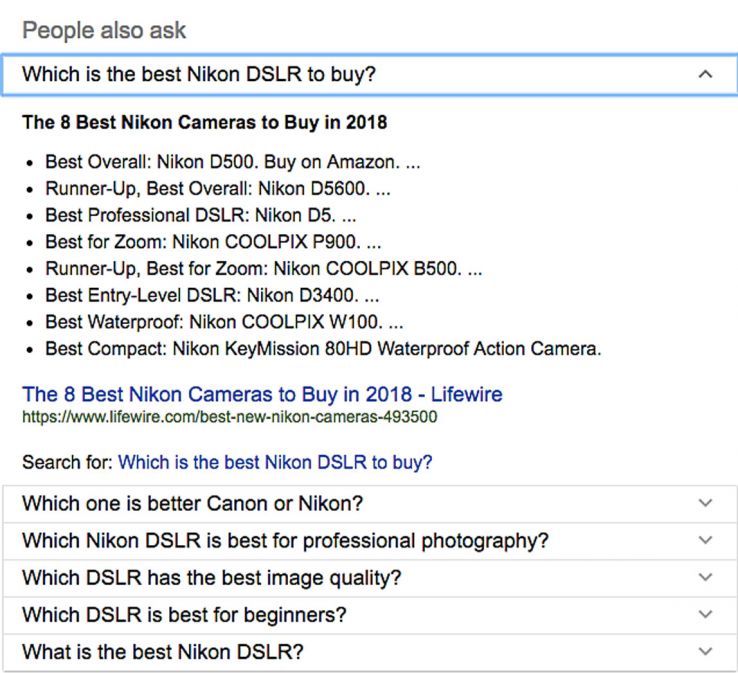
Just where are all these questions coming from, though? Are people actually asking them? If you read our previous write up on the PAA, you’ll know that Google is not always selecting these questions based on actual searched queries, as some return zero search volume when tracked.
If that wasn’t enough to raise our eyebrows, errant capitalization or non-capitalization (“how many mm are there in one Metre?”), wonky grammar (“Is aperture and f stop the same thing?”), and odd follow-up question choices (“how do you take a selfie?” for the query [easy to use digital camera]) suggest that many PAA questions are the result of machine learning.
In other words, Google is doing its darndest to understand actual search queries and spit out relevant subsequent searches to save users the effort. And it makes sense for us to be on those SERPs when searchers decide to take them up on the offer.
In order to capture all the goodies hiding in a PAA, we created a handy report. For each of your keywords that return a PAA box, our .CSV report will list the questions “also asked” (don’t worry, you’ll only get the number of PAAs that exist before things get infinitely overwhelming) and the URLs that Google sourced the answers from, plus the order they appear in.
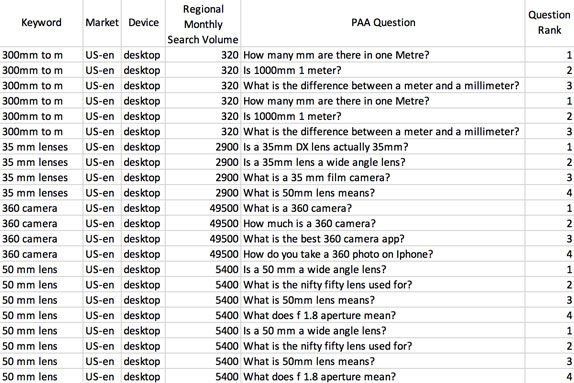
After we ran the report for our Nikon queries, we found ourselves looking at 2,838 potential new keywords. A quick scan revealed that many of our PAA boxes returned the same questions over and over again (65.57 percent were duplicates), so we set about removing those. This narrowed our PAA keyword list down to 977 topically related queries to explore.
Related searches
Another go-to for keyword inspiration are the eight related searches found at the bottom of the SERP that, when clicked, become the search query of a new SERP.

For instance, if we’re interested in ranking for “best professional cameras,” a quick look at the related searches will reveal alternative SERPs that Google thinks our searchers may be interested in, like “best professional camera for beginner,” “best dslr camera,” and “best point and shoot camera.” They help us understand how our searcher may refine or expand upon their original query.
Our related searches report makes it so that you don’t have to manually gather the “Searches related to” yourself — it takes them all and combines them into a crisp and clean .CSV spreadsheet.
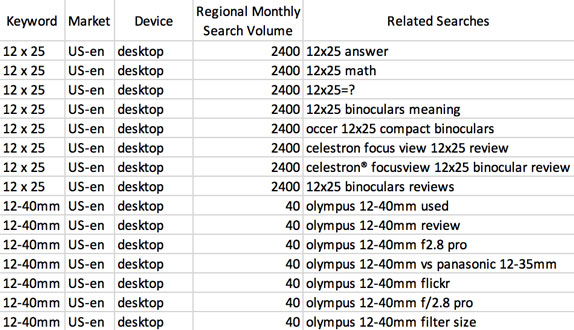
This report surfaced 12,526 keywords for Nikon, and just like with our PAA suggestions, we noticed a bunch of repeat related search offenders. After trimming out the duplicates (55.09 percent), we were left with 5,626 unique keywords to help us flesh out our Nikon project.
The “People Also Search for” box
The term “People also search for” (PASF) isn’t new to the SERP, the feature did get a major refresh back in February, which levelled things up.
Now, instead of just being attached to a knowledge graph, the PASF box also attaches itself to organic URLs and contains extra queries (up to eight on desktop; six on mobile) related to the URL that surfaces it. It’s Google’s way of saying, “Didn’t find what you’re looking for? We’ve got you — try these instead.”

This SERP feature requires you to do a little pogo-sticking in order to surface it — you need to click on the organic search result and then navigate back to the SERP before it materializes.
Obviously collecting these terms would involve a lot of work and potential finger cramps. Thankfully, there’s a handy hack to bypass all that, which is great if pogo-sticking isn’t your cup of tea. This lovely bit of JavaScript code originated from Carlos Canterello and reveals all the PASF boxes on a SERP without all the back and forth-ing.
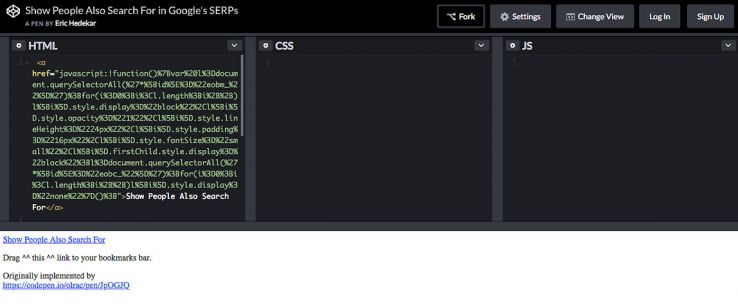
Or, for those of you feeling DIY-y, you can pull all the raw HTML SERPs and parse them yourself — sans pogo stick, sans hack. Since we’re card-carrying data nerds, we opted for this route — we pulled the raw HTML SERPs through the STAT API and had ourselves a parsing party.
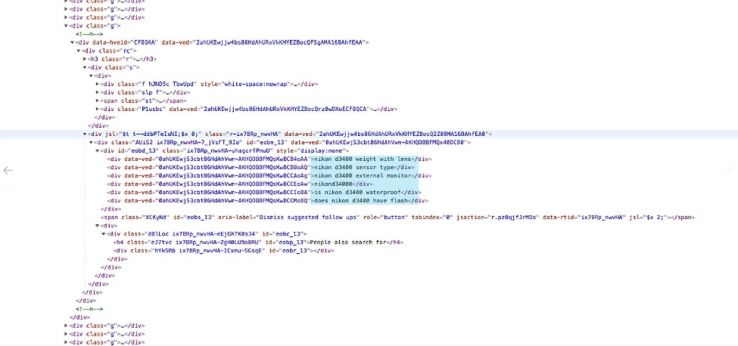
With upwards of eight PASF terms per organic result per SERP, we had oodles of keyword ideas on hand — a grand total of 59,284 to be exact (woah). Once we took away the duplicates, we were left with 18,746 unique keywords. That’s quite a drop from our original number — a whopping 68.38 percent of our keywords were repeats.
Keyword evaluation
Once our reports finished generating and we’d removed all those duplicates, we had 25,349 brand new keywords from all three features — that’s 642.71 percent more than what we started with.
While we trust Google to offer up excellent suggestions, we want to be sure we’ve got only the most relevant keywords to our project. To do this, we conducted a little keyword audit.
First, we combined all our queries into a master list and did some work to surface what was useful and remove the ones that, straight up, made zero sense, such as: “Russian ammo website,” “wallmart,” and “how to look beautiful in friends marriage,” which is super specific and very odd, but we applaud the level of dedication.
This removed 2,238 keywords from the mix, leaving us with a grand total of 23,111 keywords to creep on.
Satisfied with our brand spanking new list, we loaded those puppies into STAT to follow them around for a couple of days for further vetting.
Since we like it when things are Monica-level organized (and because smart segmentation will be key to making sense of all 23,111 of our keywords), we bagged and tagged our new queries into groups of the SERP features from whence they came so we can track which makes the best suggestions.
With our data hyper-organized, and with our search volume populated, we then selected keywords that returned no search volume and kicked them to the curb. You should do this too if you want to minimize clutter and focus on queries that will drive traffic.
We also decided to remove keywords with a search volume of less than 100. Just remember though: search volume is relative. Decide what constitutes as “low” for you — low search volume may be par for the course for your particular industry or vertical. You may just decide you want to keep low search volume keywords in your toolbox.
The rest is up to you
Now that you know how to acquire boatloads of relevant keywords straight from Google’s billion-dollar consumer research project (the SERP), it’s time to figure out what your next steps are, which is entirely dependent on your SEO strategy.
Maybe you head straight to optimizing. Perhaps you want to do more vetting, like finding the keywords that surface certain SERP features.

If, for instance, we’re interested in featured snippets and local packs, we’d look to the SERP Features dashboard in STAT to see if any of our new keywords return these features, and then click to get those exact keywords. (We’ve even got a handy dandy write-up on exploring a SERP feature strategy to help get you started.)
Whatever adventure you choose, you’re now armed and ready with a crazy number of keywords, and it’s all thanks to your comprehensive list-building, courtesy of the SERP.
Want to learn how you can get cracking and tracking some more? Reach out to our rad team and request a demo to get your very own personalized walkthrough.
If you’re ready to dig in even deeper, check out how to build an intent-based keyword list to get next-level insight.
Sign up for The Moz Top 10, a semimonthly mailer updating you on the top ten hottest pieces of SEO news, tips, and rad links uncovered by the Moz team. Think of it as your exclusive digest of stuff you don’t have time to hunt down but want to read!
![]()






Recent Comments